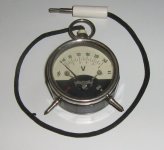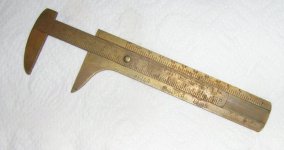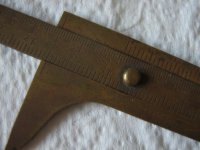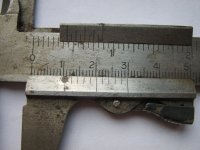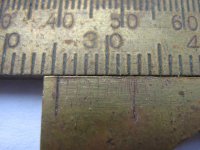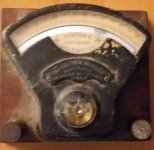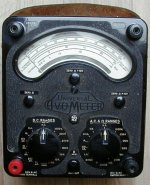From an ancester (1892 - 1954) I inherited two technical instruments.
One is a pocket volt-meter, moving-iron, 6v and 240v range, the banana plug is not original.
It could be from the 1930s because they had no public electricity there before WW2.
I know that he owned the first radio-set in the little town where he lived.
So it was possibly used to check batteries.
Radio tubes had 4v filaments, hence the 6v range.
The 4volts came from a rechargeable lead-acid battery which they had to hand carry regularly to the local miller's who had an electric generator at his water wheel.
The anode battery was possibly 150v zinc-carbon.
The other thing is a much simpler instrument, a small sliding-caliper, possibly brass-plated steel.
The max extension is 10cm / 100mm which is the lower scale.
But what puzzles me is the other two scales.
On the bottom it reads "Meter - Englisch - Paris"
If this is supposed to correspond to the three scales, then the middle scale should be english, but what english system ever used decimal subdivisions ?
The picture shows the caliper set to 25.4mm or one inch.
Now the english scale reads exactly 40 or 4.0. The only thing that comes to mind is 4/4 of an inch. But there is still the decimal subdivisions ...
But what should I make of the third scale. It runs backwards and yes, there is a separate Zero mark to accommodate this. It runs 0-3-6-9-12 a.s.o.
When set to one inch as shown it reads something like 11.
So, does anybody know what the non-metric scales are ... ?
One is a pocket volt-meter, moving-iron, 6v and 240v range, the banana plug is not original.
It could be from the 1930s because they had no public electricity there before WW2.
I know that he owned the first radio-set in the little town where he lived.
So it was possibly used to check batteries.
Radio tubes had 4v filaments, hence the 6v range.
The 4volts came from a rechargeable lead-acid battery which they had to hand carry regularly to the local miller's who had an electric generator at his water wheel.
The anode battery was possibly 150v zinc-carbon.
The other thing is a much simpler instrument, a small sliding-caliper, possibly brass-plated steel.
The max extension is 10cm / 100mm which is the lower scale.
But what puzzles me is the other two scales.
On the bottom it reads "Meter - Englisch - Paris"
If this is supposed to correspond to the three scales, then the middle scale should be english, but what english system ever used decimal subdivisions ?
The picture shows the caliper set to 25.4mm or one inch.
Now the english scale reads exactly 40 or 4.0. The only thing that comes to mind is 4/4 of an inch. But there is still the decimal subdivisions ...
But what should I make of the third scale. It runs backwards and yes, there is a separate Zero mark to accommodate this. It runs 0-3-6-9-12 a.s.o.
When set to one inch as shown it reads something like 11.
So, does anybody know what the non-metric scales are ... ?
Attachments
I still have my dad's ivory slide rule from Japan -- he was discharged from the USN in 1946. Still works, got me through high school, college and grad school.
(Damn'd Bowmar would make mistakes when the batteries got low!, slide rule never fails).
The oldest working instrument in my lab is an Eico 222 VTVM -- it cost a week's wages making french fries circa 1967.
(Damn'd Bowmar would make mistakes when the batteries got low!, slide rule never fails).
The oldest working instrument in my lab is an Eico 222 VTVM -- it cost a week's wages making french fries circa 1967.
Re. the caliper:
1) You can easily test if the material is brass or plated steel by using a magnet (won't stick to brass or similar alloys)
2) Sorry to nit-pick, but from your picture it looks like 40 on the middle scale corresponds to somewhere between 25.1 & 25.2 on the lower scale; not 25.4 as you've stated. It is close enough to suggest your conclusion, though. Do you know where in the pre-EU this might have originated? I've heard that in Deutschland, the inch ("Zoll") & foot ("Fuß") were in common use in years past, possibly in parallel with the metric system. Perhaps their definition of the inch varied slightly from today's convention?
3) You may be surprised to know that decimal divisons are/were VERY common with the English/"Imperial" measurement system as we were taught it - any precision machining work and calipers, micrometers, etc. were graduated in decimals (10th's/100th's/1000th's) of an inch.
1) You can easily test if the material is brass or plated steel by using a magnet (won't stick to brass or similar alloys)
2) Sorry to nit-pick, but from your picture it looks like 40 on the middle scale corresponds to somewhere between 25.1 & 25.2 on the lower scale; not 25.4 as you've stated. It is close enough to suggest your conclusion, though. Do you know where in the pre-EU this might have originated? I've heard that in Deutschland, the inch ("Zoll") & foot ("Fuß") were in common use in years past, possibly in parallel with the metric system. Perhaps their definition of the inch varied slightly from today's convention?
3) You may be surprised to know that decimal divisons are/were VERY common with the English/"Imperial" measurement system as we were taught it - any precision machining work and calipers, micrometers, etc. were graduated in decimals (10th's/100th's/1000th's) of an inch.
...Perhaps their definition of the inch varied slightly from today's convention?...
The English Inch comes from the English Yard which only in theory is three of the King's feet, or the average of the first 16 men to come out of church.
Yard - Wikipedia
Foot (unit - Wikipedia)
Inch - Wikipedia
Yard-keeping seems to have been formally informal until 1825. There was a fire in 1834. 1845-1855, forty bronze Yards were made. US and Canada each got a copy. Meanwhile France was really spiffing-up their yard (meter) stick, and it was far more stable than the older English Yards. After 1898 the Yard was accepted as 36⁄39.370113 or 0.914399204 of a meter. Gradually 1866-1959 this was made exactly 0.9144 meters (which had apparently already been widely used). This makes an inch 25.4mm exactly. While in US metrics there is an "old inch" used only by micrometer makers (the only ones who aspired to great accuracy), the 25.4mm inch is very very old. I would be very dubious about any eye-slide or even vernier which did not match 25.4mm=1".
However there may have been many "inches" in the 1800s.

You should look up Vernier scales! A method of increasing readout resolution before the digital age. Also explains why decimal calibration.
I grew up with analog verniers or nonius as it was called, and here's an example - a little corroded - set to 10.7 mm .
But hold on ... now that you mentioned it, a closer look actually reveals a makeshift vernier on the brass tool, hardly visible, crudely scratched ...
And the material might be solid brass, it is indeed non-magnetic.
Attachments
The third scale looks like 1/100 ths.
I have got one of those pocket meters that also has an ohms range.
The battery terminals have rotted away but it does still work on voltages.
don't get that ... 1/100th of what ?
Re. the caliper:
3) You may be surprised to know that decimal divisons are/were VERY common with the English/"Imperial" measurement system as we were taught it - any precision machining work and calipers, micrometers, etc. were graduated in decimals (10th's/100th's/1000th's) of an inch.
you're right, I worked in the semiconductor industry and mils / sq mils were common for die size.
Weston meter low serial number (the scale is actually hand written on a printed template) so ~1890. As was the practice you enhanced resolution by using a mirror and parallax. I had a later version that I used to monitor my off grid solar setup. It was last calibrated in 1950 three days after I was born and was easily better than 1% out of the box (dumpster)  .
.
Attachments
I still use my trusty AVO8 which was gifted to me 50 years ago! Still good to 1% and great for monitoring adjustment nulls. Built like a tank with a ballistic overload cutout to avoid the "needle wrapped around the end stop" syndrome.
The box with the moving arm, as my younger sister described it once! I'll bet a fair number of older (= ancient) UK members have one.
The box with the moving arm, as my younger sister described it once! I'll bet a fair number of older (= ancient) UK members have one.
Attachments
I have got two of the very similar AVO9s.I still use my trusty AVO8 which was gifted to me 50 years ago! Still good to 1% and great for monitoring adjustment nulls. Built like a tank with a ballistic overload cutout to avoid the "needle wrapped around the end stop" syndrome.
The box with the moving arm, as my younger sister described it once! I'll bet a fair number of older (= ancient) UK members have one.
I have always fancied an AVO 8 but I keep blowing up DMM's !
Usually shove voltage through the current range and fry something.
Must remember to leave meter on high volts range.
We had one at the first electronics company I worked for in 1980.
We had a really old Spectrum Analyser too, I think it was HP.
Usually shove voltage through the current range and fry something.
Must remember to leave meter on high volts range.
We had one at the first electronics company I worked for in 1980.
We had a really old Spectrum Analyser too, I think it was HP.
How could it be inaccurate unless actually bent or damaged in some way?My Dad gave me a vernier caliper that he used when he was a fitter and turner in the 40s. It was horribly inaccurate, I got rid of it and now use a cheap plastic one with an electronic readout.
- Home
- Design & Build
- Equipment & Tools
- Vintage Instruments
